Rostec delivers Pantsir-S to Russian forces
Rostec’s High-Precision Systems has delivered a batch of Pantsir-S ground-based air defence (GBAD) systems to the Russian armed forces according to a 20th March announcement from Rostec.
The systems were ordered under the state defence programme, and accepted into service following a series of tests, the announcement states. “Pantsir crews have repeatedly detected and destroyed complex air targets during combat duty, and the system has proven its ability to destroy virtually the entire range of air attack weapons used by the enemy,” it adds. Although, Ukraine has recently conducted several successful strikes, including one against the Engels Airbase, home to Russia’s strategic bomber fleet. Recent videos also indicate a specific Ukrainian drone is being used to target air defence radars with some levels of apparent success against Pantsirs.
Pantsir-S is manufactured by the Tula Instrument-Making Design Bureau, which sits within the High-Precision Systems holding. The system has been subject to upgrades designed to improve its performance against drones and missiles, according to a 2024 Rostec press release covering the delivery of another batch of the vehicles.
This improved capability specifically includes the guided rockets fired by the M142 HIMARS, according to a 2023 interview with Bekkhan Ozdoyev, the industrial director of Rostec’s defence cluster that was published by TASS. Production of the Pantsir-S has been increased and new versions are also being developed, according to Ozdoyev, although Rostec has not reported any further deliveries beyond one in October 2024 and this one since the invasion began in 2022.
It is not clear what is meant by the Pantsir-S specifically, as the vehicle was developed into the Pantsir-S1 before entering service and a further improved variant, the Pantsir-SM was presented at a trade show in 2019. The SM has an improved range and engagement capability over the basic Pantsir-S and has been deployed to Ukraine according to Ria Novosti.
A further variant of the Pantsir, the Pantsir-SMD-E, was presented in 2024 and touted as a system designed to repel massed drone attacks. It is a towed system designed to be installed at an industrial site or somewhere similar and provide protections against drone and missile attacks. It reportedly has the ability to carry 48 TKB-1055 short-range air defence missiles or 12 of the Pantsir’s standard 57E6 series missiles. This type of development is understandable given both the Ukrainian attacks against Russia’s critical national infrastructure, but also past attacks in the Middle East like the 2019 drone attack on the Saudi Arabian ARAMCO oil processing facility.
Tech profile: Pantsir-S

The Pantsir-S1 is shown here with its radar stowed. The system is designed to provide what is effectively the last line of defence against low-flying cruise missiles and larger drones. Credit: Rostec.
The Pantsir-S1 that eventually entered service with the Russian Aerospace Forces (VKS), which includes the Russian Air Force. They are expected to provide GBAD of critical nodes within Russia such as airbases, nuclear missile sites, and critical national infrastructure, rather than accompany Russia’s Ground Troops into combat. It is a truck-mounted system armed with two 2A38M double-barrelled 30 mm automatic cannons and 12 57E6 series missiles providing an engagement envelope out to a range of 20 km and altitude of 15 km. The cannons remain lethal out to ranges of 4,000 m and altitudes of 2,000 m.
The vehicle carries its own surveillance and tracking radars, provided by the 2RL80 S-band radar and the Phazotron 1RS2-1 Schlem respectively. It is also fitted with an electro-optic suite that can be used for passive engagements without the radars. This enables the Pantsir-S1 to engage targets autonomously, but it can also be paired with the Kasta 2E2 radar vehicle to improve its detection range and capability. A battery typically consists of 4 – 6 vehicles.
Calibre comment
The system is somewhat effective in its role, but likely vulnerable to certain types of threat like low and slow drones, which are difficult to detect. As with all air defence systems, the sum of the parts when properly connected is more effective than a single isolated system. So, on occasions where the Pantsir-S is accompanied by other radars or longer-range missile systems, it likely provides an effective layer of short-range air defence against most of the weapons available to Ukraine. For instance, one account released by the Russian MoD in February 2025 indicates that a single vehicle engaged 16 Ukrainian drones, requiring a reload of its missile stocks to complete the mission. Another report from 2023 claims that the system was able to defeat eight Tochka-U tactical-ballistic missiles, and that it had been updated to defeat the UK’s StormShadow cruise missiles, including improvements to the radar and the power of the missiles.

Sign Up for Updates!
Get insider news, tips, and updates. No spam, just the good stuff!





